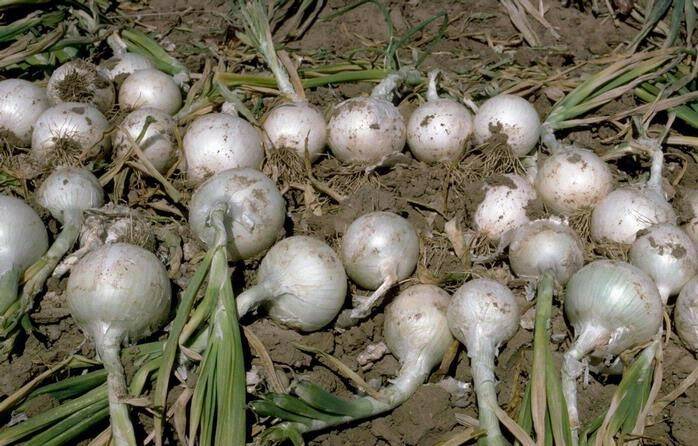Question: I planted onions from seed last year. The package said they form 3 to 4-inch bulbs. The seeds sprouted and grew leaves but none of the plants produced bulbs. What went wrong?
Answer: There are several reasons that onions might not bulb. Understanding the onion’s life cycle and its growth requirements might help you harvest full-sized onions in the future.
Garden onions (Allium cepa) are biennial plants. That means they take two growing seasons to go from seeding to seed production. During the first growing season after sowing, an onion seed sprouts, grows leaves and roots and forms a bulb. During the second season, the bulb provides the plant with energy for further growth, flowering and seed production.
What triggers bulb formation in the first growing season? Bulb formation begins as the days grow longer and a certain length of daylight (i.e., hours of daylight) occurs. The more foliage the plant has before that critical day length is reached, the bigger the bulbs will get.
If the plant has not reached an adequate size when the magic number of daylight hours occurs, it will not be able to support bulb development. As a result, the bulb will not enlarge.
Onion varieties initiate bulb formation at different day lengths and are categorized into two groups: short-day and long-day onions. Short-day varieties start bulb development when day length reaches 10-12 hours; long-day varieties initiate bulb development at 14-16 hours of daylight.
Short-day onions typically are grown in the south (latitudes of 25-35 degrees) where onions can be planted in the fall or late winter and plants grow to a sufficient size by early spring (i.e., when days reach 10-12 hours in length). If short-day onions are planted in the north (latitudes above 35 degrees) where planting cannot occur until late winter, the plants will not have grown sufficiently to support bulb formation when bulb initiation occurs.
Long-day onions are better suited for northern climates (such as Washington state). Even though planting is delayed until late winter or early spring in these locations, the plants will grow sufficiently before day length reaches 14-16 hours and will form bulbs. Long-day onion varieties recommended for the North Olympic Peninsula include Ailsa Craig, Patterson and Walla Walla.
The timing of planting is still critical. Even if you plant long-day onions, plants must be well-established and have sufficient leaf mass when bulb formation is triggered.
So, when should you plant long-day varieties on the North Olympic Peninsula? If you are growing onions from seed, plant the seed by mid-February. Because the ground is too cold and wet at this time, you will have to start the seeds indoors and transplant the seedlings once all danger of frost has passed.
Alternatively, you could purchase onion sets (young, small dormant bulbs grown the previous year) or commercially grown seedlings which do not take as long to become established once planted in the garden. Sets should be planted on the North Olympic Peninsula from March to early April; seedlings should be planted from March to May.
Good care is important for a good onion harvest. Onion roots are shallow and not efficient at taking up moisture. Keep the soil evenly moist, providing about one inch of water each week.
Because onions don’t compete well with other plants, keep the planting as weed-free as possible. Be careful when cultivating around the plants so as not to disturb their shallow roots. Organic mulch can help control weeds and maintain an even soil moisture.
Onions are heavy feeders. Fertilize with fish emulsion or a 5-10-10 fertilizer early in the season. Apply fertilizer again about a month after the first application.
After sprouting, onions take three to five months to reach a mature size, depending on the climate and variety. You will know when they are ready for harvest when the bulbs are big and the tops begin to turn yellow and fall over.
For more information about growing onions, download Washington State University’s “Growing Onions in Home Gardens” at tinyurl.com/SEQmgonions.
Jeanette Stehr-Green and Michele Mangiantini are WSU-certified Clallam County Master Gardeners.



